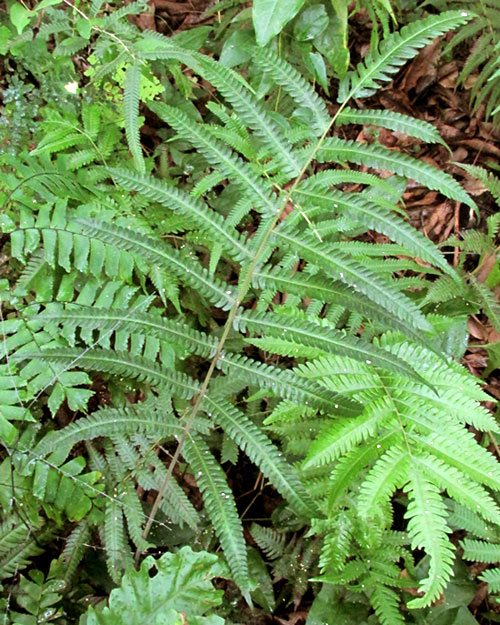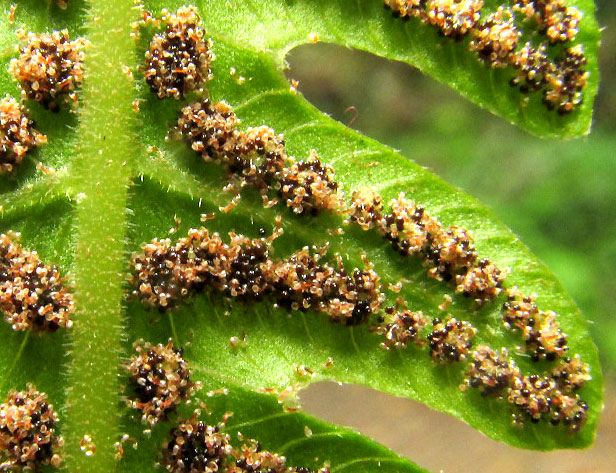Excerpts from Jim Conrad's
Naturalist Newsletter
entry from field notes dated October 6, 2022, taken along the main road on the northern side of Gómez Farías, on the lower eastern slope of the Eastern Sierra Madres, El Cielo Biosphere Reserve, southern Tamaulipas state, MÉXICO; elevation about 350m (1150 ft), ± LAT. 23.04°N, LONG. 99.15°W
FREETIP MAIDEN FERN

In the understory of a somewhat disturbed wooded area on a steep, deeply shaded slope just below the road leading out of town, about 1.5km north of the central park, the above fern species formed a fern thicket about the size of a one-car garage. With the fronds' general form, and main subdivisions, the pinnae, so deeply cut into side-by-side lobes -- the fronds are "pinnate pinnatifid" -- plus the lower pair of pinnae being a little smaller and backward projecting, the fronds were similar to the Maiden Fern we've seen in southwestern Texas.
However, at this distance, viewing the whole frond, to me the most distinctive feature was that the pinna at the frond's tip was set apart and very similar to the side pinnae. Usually pinnae at the tips of fronds of this general character gradually diminish toward the tip until they become mere lobes of the frond tip, as shown on the Torres's Fern we've seen Mississippi. This species' frond tip is its best field mark.

The deeply cut, or pinnatifid, pinnae also arose unusually far from one another on a rather solid and stiff rachis that was round in cross-section.

The above close-up of a pinna's undersurface displays several features important for identification. The clusters of spore-producing sporangia, or sori, are roundish, not elongated, and there's no hint of a papery indusium associated with each sorus. The pinna's midrib, or costa, is densely covered with short hairs.
However, maybe the most critical feature visible in the picture -- which is hard to see -- is most evident at the above picture's top, right corner, at the base of the cut, or sinus, closest to the picture's edge. At the base of the sinus, a vein runs halfway straight down through the connecting tissue between the two pinna lobe bases, then forks, with each bifurcation going to a sorus, passing beneath it, and connecting to the base of the lobe's midvein, where the midvein connects to the pinna's costa. It's an obscure detail, but determinative.
When you see fronds of this one's general form and with similar sori, two fern families might come to mind: The Marsh Fern Family, the Thelypteridaceae, and the Wood Fern Family, the Dryopteridaceae. Among differences between those two families is that marsh ferns may bear tiny, needlelike hairs, while wood ferns don't. Our fern bears such hairs, so I looked into the Marsh Fern Family.
Mexican ferns are not well documented, but fern species disperse great distances with their microscopic, airborne spores, so I hoped the Marsh Fern Family treatment in the Flora of North America might lead me to this species, and it did. With the frond's deeply pinnate-pinnatifid form, I was led to the genus Thelypteris. Then I ran into trouble, because to "key out" our fern to a species matching pictures and descriptions on the Internet, I had to claim that our fern bears at least a few star-shaped, or stellate, or otherwise forked hairs, and I simply never saw such hairs on our fern. They were all simple needlelike ones. Maybe if our fern hadn't been in such deep shade I'd have seen them.
If I admit to our fern bearing some stellate or otherwise forked hairs, in the Flora of North America our plant with its "apical pinna similar to lateral pinnae" keys out directly and convincingly to THELYPTERIS TETRAGONA. That species' features appear to match our fern in every respect, if our fern in fact bears some branched hairs.
Thelypteris tetragona often is called the Freetip Maiden Fern, honoring the unusually separated frond tip shaped like a side pinna, though the Flora of North America refers to it as the Free-tip star-hair fern, highlighting those "star-hairs" I've not seen. The species occurs in damp woods in Florida in the US, plus Mexico south through Central America to northern South America, and the Caribbean area.
This is one of those species about which very little information can be found, other than that it has been identified and listed as existing here and there in the Americas. On this page we can at least add that if you want to see those star-shaped or otherwise branched hairs, you may have to look hard to see them.